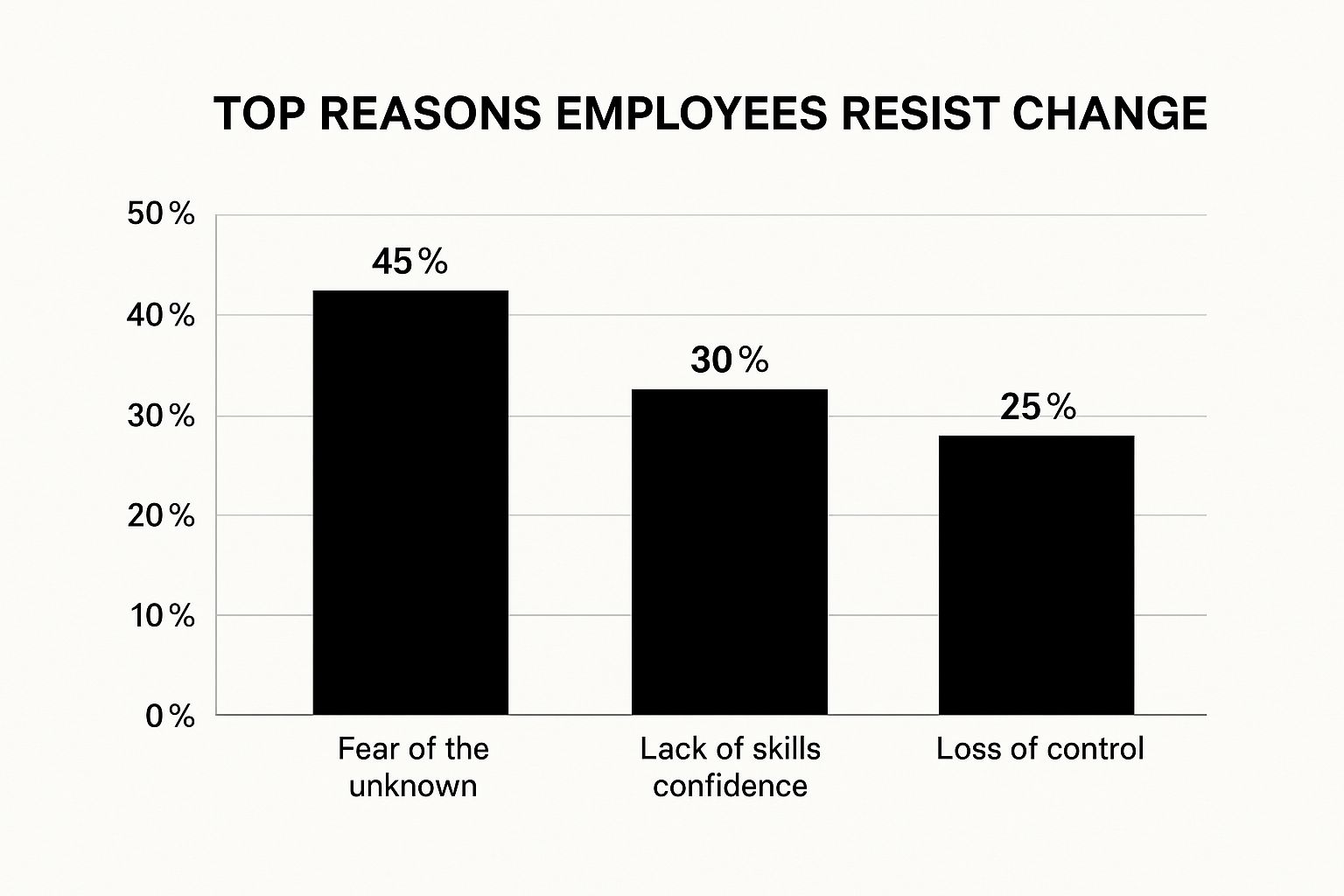Why People Really Resist Change (And What's Behind It)

Change can be unsettling, even when it's for the better. This feeling often comes from a deep-seated need for security and predictability. Our familiar routines offer us comfort, so straying from them can feel like a threat, even if the potential benefits are clear. This section explores these underlying reasons so HR professionals can better navigate the complexities of change management.
The Psychology of Resistance
Resistance to change isn't just stubbornness. It's a complex mix of emotions and perceptions. Uncertainty can trigger our survival instincts, making us wary of what we don't know. Even small changes can activate a stress response. Our past experiences, especially negative ones, also play a huge role. A past change initiative that didn't go well can create skepticism and fear about future changes.
Sometimes, resistance isn't even a conscious decision. People may not realize they're resisting. This can show up as procrastination, lower productivity, or passive-aggressive behavior. These subtle signs can be just as harmful as outright opposition. Understanding the psychology behind resistance allows HR professionals to address the root of the problem.
Common Drivers of Resistance
Several key factors regularly contribute to resistance in the workplace. Fear of the unknown is a major driver. This includes concerns about job security, competence, and the impact on established routines. Another common driver is a lack of trust in leadership. If employees question the need for change or don't believe it will benefit them, they're unlikely to embrace it.
Loss of control is another significant factor. When people feel they have no voice in the change process, they're much more likely to push back. Resistance to change continues to be a widespread challenge, with studies revealing that roughly 76% of change initiatives face some level of resistance. This resistance often arises from a lack of clarity and trust. 39% of employees express confusion about the reasons for change, while 41% point to a lack of trust in leadership as key reasons for resisting. Fear of the unknown impacts 38% of employees. Another 27% resist due to potential changes in their job roles, and 23% feel excluded from the decision-making process. These statistics underscore the importance of clear communication, employee involvement, and strong leadership in effectively managing change. Find more detailed statistics here: https://mooncamp.com/blog/change-management-statistics
Recognizing the Early Warning Signs
Spotting resistance early is crucial. HR professionals need to be sensitive to both verbal and nonverbal cues. Negative comments, disengagement, and a drop in productivity can all be early signs of resistance. It's also important to remember that resistance isn't always bad. It can offer valuable feedback.
By acknowledging and addressing concerns early on, HR professionals can turn resistance into an opportunity for improvement. This proactive approach can save the initiative and strengthen employee trust and engagement. In the next section, we'll explore the hidden costs of unmanaged resistance and its ripple effects throughout the organization.
The Hidden Costs of Unmanaged Resistance
Embracing change can be challenging, but resisting it can have far-reaching consequences that extend beyond missed deadlines and impact the very heart of your organization. These hidden costs, often unseen in traditional Return on Investment (ROI) calculations, can significantly hinder your organization's health and potential.
The Domino Effect of Resistance
Even small pockets of resistance can trigger a cascade of negative consequences, impacting various aspects of your organization. Imagine a team resisting a new software implementation. This can decrease productivity, not only for that team but also for interconnected teams relying on their output. This can lead to missed targets, potentially affecting revenue and overall organizational success. Furthermore, unaddressed resistance can damage team dynamics, fostering resentment and distrust among colleagues.

This infographic illustrates the top three reasons employees resist change. Fear of the unknown (45%), lack of skills confidence (30%), and loss of control (25%) emerge as the primary drivers. Addressing these core concerns is crucial for effectively navigating change and fostering a positive, adaptable work environment.
To better understand the potential impact of resistance, let's examine the following table:
The Real Cost of Change Resistance: This table reveals the often-overlooked impacts of poorly managed resistance to change across multiple dimensions of organizational performance.
| Impact Area | Short-Term Consequences | Long-Term Consequences |
|---|---|---|
| Productivity | Decreased output, missed deadlines | Reduced competitiveness, loss of market share |
| Employee Morale | Frustration, resentment, decreased engagement | Increased turnover, difficulty attracting talent |
| Innovation | Stifled creativity, reluctance to embrace new ideas | Stagnation, inability to adapt to market changes |
| Leadership Credibility | Loss of trust, diminished influence | Reduced effectiveness, difficulty implementing future changes |
| Financial Performance | Lost revenue, increased costs | Decreased profitability, weakened financial position |
As the table demonstrates, the consequences of unmanaged resistance are substantial and can impact various facets of organizational performance. Addressing resistance proactively is key to mitigating these risks and ensuring long-term success.
Long-Term Consequences and Cultural Toxicity
The impact of unmanaged resistance doesn't simply vanish after a change initiative concludes. It can permeate the organizational culture, breeding cynicism and negativity, making future changes even more daunting. This can stifle innovation, making employees hesitant to embrace new ideas and hindering the organization's ability to adapt and thrive.
Statistical data paints a stark picture: roughly 66% of change initiatives fail, with only 34% succeeding. Employee resistance and change fatigue are major contributing factors, identified by 50% of communications leaders as top challenges. Shockingly, only 26% of organizations effectively implement change management practices. Resistance is particularly pronounced among younger employees, with 41% of those aged 25 to 34 struggling with adaptability. You can explore more detailed statistics here: https://www.walkme.com/blog/change-management-statistics/
Unmanaged resistance can also erode leadership credibility. When change initiatives repeatedly falter due to resistance, employees may lose faith in leadership’s ability to guide the organization effectively. This can lead to disengagement and even talent flight, as valuable employees seek opportunities elsewhere. These long-term consequences, while less tangible than immediate project delays, are no less detrimental to an organization's overall success. Investing in effective strategies for managing resistance to change is not merely a best practice; it is a necessity for sustained organizational health and growth.
Breaking Through Organizational Barriers To Change

Even with enthusiastic team members, an organization's structure can create resistance to change. This isn't about individual employees resisting new ideas; it's about the systems and processes working against transformation. Understanding these systemic issues is the first step to successful change management.
Identifying Structural Impediments
Legacy systems, often outdated and inflexible, can be a major roadblock. Imagine implementing modern project management software when your organization still relies on paper-based approvals. This mismatch creates friction and frustration, fueling resistance. Hierarchical bottlenecks, where decisions require multiple layers of approval, slow progress and stifle initiative. Even small changes become herculean efforts.
Departmental silos also create a "not-my-problem" mentality. When departments operate in isolation, they may resist changes that benefit the whole organization but disrupt their workflows. This lack of collaboration undermines change initiatives.
The Impact of Competing Priorities and Resources
Resistance is often intensified by competing priorities. When employees are already overworked, they may resist new initiatives that add to their workload, even beneficial ones. This highlights the need for aligning priorities and allocating resources effectively. Without adequate resources—time, budget, and personnel—change initiatives are destined to fail.
Decision-making frameworks can also contribute to resistance. Slow, opaque, or overly centralized decision-making creates frustration and discourages buy-in. If front-line employees feel unheard, they’re less likely to support changes. Leadership recognizes these internal factors. 37% of executives identify failure to adapt the operating model as the main obstacle to change management. 30% cite legacy systems as barriers, and 28% point to organizational culture and competing priorities. Explore more statistics on change management: Change Management Statistics.
Redesigning For Change
Successfully navigating change requires proactively reshaping organizational structures. This includes redesigning processes to be more flexible and adaptable. Streamlining approvals removes bottlenecks and empowers employees.
Modernizing governance to encourage collaboration and transparency is also essential. Creating cross-functional teams or implementing new communication channels can break down silos. Finally, aligning measurement systems with the desired change outcomes reinforces new behaviors and tracks progress. This ensures everyone works towards the same goals and that success is measurable. By addressing these structural issues, organizations create environments where change is embraced.
Communication That Transforms Resistance Into Support
Successfully navigating change within an organization depends heavily on clear, consistent, and empathetic communication. It's not just about announcing the change; it's about crafting a story that resonates with your team, addressing their concerns, and inspiring them to embrace the journey.
Crafting Compelling Narratives
Think of communicating change as telling a story. Every good story has a beginning (the current state), a middle (the transition), and an end (the desired future). This narrative must be genuine, transparent, and explain the why behind the change. For instance, instead of simply announcing a new software implementation, explain how it will simplify tasks, improve productivity, and benefit both individual team members and the organization as a whole.
Customizing Messages and Timing Communications
Different groups within your organization will have different perspectives and priorities. Leadership may focus on the strategic advantages, while team members are more concerned with the practical impact on their daily work. Tailoring your communication is key. Town hall meetings are great for broad announcements, while smaller team meetings provide a forum for addressing specific concerns and fostering more in-depth conversations.
Strategic timing is also critical. Communicate early and often, but avoid information overload. Start with a general announcement and gradually share more details as the change progresses. This phased approach keeps everyone informed, minimizes uncertainty, and allows for smoother transitions.
Creating Authentic Two-Way Dialogues
Communication shouldn't be a one-way street. Encourage feedback and address concerns head-on. Tools like surveys, focus groups, and one-on-one discussions can uncover hidden resistance early on, providing valuable insights that can help you refine the change initiative and ensure its success. For established guidance in navigating these conversations, consider leveraging change management best practices.
Maintaining Consistency and Acknowledging Concerns
Change is rarely a smooth, linear process. There will be challenges. Consistent communication, even when things get difficult, builds trust and reinforces leadership credibility. Equally important is acknowledging valid concerns and demonstrating empathy. This doesn’t mean agreeing with every concern, but it does mean listening respectfully and explaining the rationale behind decisions.
Practical Communication Strategies
Effective communication can turn resistance into support by fostering understanding and encouraging buy-in. Consider these essential strategies:
- Active Listening: Focus on understanding, not just responding.
- Empathy: Recognize and acknowledge the emotional impact of change.
- Transparency: Be open and honest about the process, including challenges.
- Two-Way Communication: Create avenues for feedback and open dialogue.
- Storytelling: Craft a compelling narrative that resonates with your audience.
The table below provides actionable communication strategies for different types of resistance. It acts as a practical guide, matching specific approaches to common concerns and offering clear direction on what works and what to avoid.
Communication Strategies for Different Resistance Types
| Type of Resistance | Key Communication Approach | Do's | Don'ts |
|---|---|---|---|
| Fear of the Unknown | Provide clear and consistent information about the change process and expected outcomes. | Explain the “why” behind the change, emphasize benefits, and offer training and support. | Don't minimize concerns or dismiss fears. |
| Lack of Trust | Be transparent and honest about challenges and setbacks. | Acknowledge past mistakes and demonstrate a commitment to learning. | Don't overpromise or make unrealistic assurances. |
| Loss of Control | Involve employees in the change process and give them a voice. | Offer choices and opportunities for input. | Don't dictate or impose solutions. |
| Impact on Workload | Acknowledge the added burden and provide resources and support. | Offer training and adjust deadlines as needed. | Don't dismiss concerns or downplay the impact. |
By implementing these strategies, organizations can create a supportive environment for change, leading to increased buy-in and ultimately, lasting success.
Building a Change Champion Network That Actually Works

Effective change management thrives on more than just directives from the top. It requires a network of advocates—your change champions—working within the organization. These individuals are the bridge between leadership's vision and the day-to-day realities of the teams implementing the change. Let's explore how to build a change champion network that truly fuels adoption.
Identifying and Selecting Effective Champions
Building a powerful change champion network starts with finding the right people. It's not just about enthusiasm; it's about credibility and influence. Seek out individuals respected by their peers, who communicate effectively, and genuinely understand the change and its potential.
Influence isn't always about titles. Mapping the informal networks in your organization can reveal powerful influencers. Who do people turn to for advice? A long-tenured employee with deep company knowledge might hold more sway than a newly appointed manager. These informal leaders can be incredibly effective change agents within their teams.
Equipping Champions for Success
Once identified, your change champions need the right support to thrive. Equip them with clear, consistent information about the change. Address their concerns. Give them the authority to advocate within their teams.
Training is essential. Provide your champions with the skills to communicate effectively, address resistance, and answer questions. Empower them further by including them in the change process. Their participation builds ownership and enhances their credibility. Their frontline perspective can provide valuable insights, helping to refine the strategy and address potential roadblocks.
Maintaining Engagement and Measuring Impact
Sustaining engagement, particularly during challenging periods, is critical. Regular communication, feedback sessions, and recognition are key. These interactions offer opportunities to address concerns, provide support, and ensure your champions feel valued.
Measuring the impact of the network is also important. Track key metrics like adoption rates, employee feedback, and progress towards desired outcomes. Analyzing this data provides insights into the network's effectiveness and pinpoints areas for improvement. This data-driven approach ensures continuous improvement, contributing to the overall success of the change initiative.
Building an effective change champion network is a strategic endeavor. By identifying the right people, equipping them for success, maintaining their engagement, and measuring their impact, organizations can transform resistance into support and accelerate change adoption. This sets the stage for our next discussion: the crucial leadership skills that drive successful change.
The Leadership Skills That Turn Resistance Into Results
Managing resistance to change isn't about squashing objections. It's about guiding people through a transition. This requires specific leadership skills that go beyond traditional management. These skills empower leaders to transform resistance from an obstacle into valuable input and a chance to grow.
Adaptive Resilience: Navigating Uncertainty
Change is rarely a straight line. Adaptive resilience is the ability to navigate the unknown, rebound from setbacks, and adjust plans as needed. Leaders with this skill don’t see unexpected problems as failures; they see them as learning opportunities. This resilience inspires their teams and creates a flexible environment.
Authentic Listening: Hearing Beyond Words
Authentic listening means truly hearing and understanding people’s concerns about change. It's more than just acknowledging what they say; it's empathizing with their feelings and perspectives. This builds trust, allowing individuals to express their worries openly. For example, a leader who actively listens might learn that resistance to new software isn't about the software itself, but about a lack of training.
Constructive Conflict Navigation: Turning Disagreement Into Dialogue
Resistance often shows up as conflict. Constructive conflict navigation is the skill of managing disagreements productively, focusing on common goals. It’s about encouraging conversation, not silencing dissent. This skill helps leaders turn conflict into a chance for teamwork and innovation.
Emotional Regulation: Leading With Calm
Change can be emotional. Leaders who practice emotional regulation stay calm under pressure. This creates stability and reassurance for their teams, easing anxiety and encouraging rational decisions. Leaders who manage their own emotions well model the behavior they want to see in their teams.
Building Psychological Safety: Creating Open Communication
Psychological safety is key to managing resistance. It's about creating a place where people feel safe sharing their concerns without fear of judgment. This empowers them to offer valuable insights that can improve the change and build stronger teams. A robust change initiative relies on motivated individuals. For ideas to energize your team, consider strategies to improve developer experience.
Leading by Example: Modeling the Desired Behaviors
Leaders who manage resistance well embody the changes they expect from others. They show vulnerability by acknowledging their own struggles, which builds trust and encourages others to embrace the transition. This leading by example approach reinforces the idea that everyone is working together.
Adapting Leadership Styles: Responding to Different Situations
Resistance comes in many forms. Effective leaders adapt their style to each situation. Sometimes, a direct approach is needed; other times, collaboration works better. This flexibility allows leaders to address varied concerns and create the best strategies.
Developing these leadership skills is an ongoing journey. Through self-reflection, training, and practice, leaders can learn to navigate resistance and turn it into positive change. Ready to grow your HR skills and lead change with confidence? Explore programs offered by the Global Human Resource Institute (https://www.globalhrinstitute.website) and empower yourself to navigate today’s dynamic HR landscape.




0 Comments